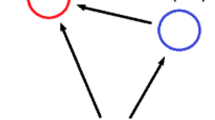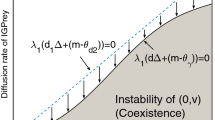Abstract
This paper considers intraguild predation (IGP) systems where species in the same community kill and eat each other and there is intraspecific competition in each species. The IGP systems are characterized by a lattice gas model, in which reaction between sites on the lattice occurs in a random and independent way. Global dynamics of the model with two species demonstrate mechanisms by which IGP leads to survival/extinction of species. It is shown that an intermediary level of predation promotes survival of species, while over-predation or under-predation could result in species extinction. An interesting result is that increasing intraspecific competition of one species can lead to extinction of one or both species, while increasing intraspecific competitions of both species would result in coexistence of species in facultative predation. Initial population densities of the species are also shown to play a role in persistence of the system. Then the analysis is extended to IGP systems with one species. Numerical simulations confirm and extend our results.




Similar content being viewed by others
References
Abrams PA, Fung SR (2010) Prey persistence and abundance in systems with intraguild predation and type-2 functional response. J Theor Biol 264:1033–1042
Dong Q, Polis G A (1992) The dynamics of cannibalistic populations: a foraging perspective. In: Cannibalism: ecology and evolution among diverse taxa. Oxford University Press, New York, pp 13–37
Han R, Dai B (2017) Spatiotemporal dynamics and spatial pattern in a diffusive intraguild predation model with delay effect. Appl Math Comput 312:177–201
Hofbauer J, Sigmund K (1998) Evolutionary games and population dynamics. Cambridge University Press, Cambridge
Holt RD, Polis GA (1997) A theoretical framework for intraguild predation. Am Nat 149:745–764
Hsu SB, Ruan S, Yang TH (2015) Analysis of three species LotkaCVolterra food web models with omnivory. J Math Anal Appl 426:659–687
Iwata S, Kobayashi K, Higa S, Yoshimura J, Tainaka K (2011) A simple population theory for mutualism by the use of lattice gas model. Ecol Model 222:2042–2048
Kang Y, Wedekin L (2013) Dynamics of a intraguild predation model with generalist or specialist predator. J Math Biol 67:1227–1259
Matsuda H, Ogita N, Sasaki A, Sato K (1992) Statistical mechanics of population: the lattice Lotka-Volterra model. Prog Theor Phys 88:1035–1049
Perko L (2001) Differential equations and dynamical systems. Springer, New York
Polis GA, Holt RD (1992) Intraguild predation: the dynamics of complex trophic interactions. Trends Ecol 7:151–154
Polis GA, Myers CA, Holt RD (1989) The ecology and evolution of intraguild predation: potential competitors that eat each other. Annu Rev Ecol Syst 20:297–330
Ruggieri E, Schreiber SJ (2005) The dynamics of the Schoener–Polis–Holt model of intraguild predation. Math Biosci Eng 2:279–288
Shu H, Hu X, Wang L, Watmough J (2015) Delayed induced stability switch, multitype bistability and chaos in an intraguild predation model. J Math Biol 71:1269–1298
Tainaka K (1988) Lattice model for the Lotka-Volterra system. J Phys Soc Jpn 57:2588–2590
Tainaka K (1989) Stationary pattern of vortices or strings in biological systems: lattice version of the Lotka-Volterra model. Phys Rev Lett 63:2688–2691
Wang Y, DeAngelis DL (2016) Stability of an intraguild predation system with mutual predation. Commun Nonlinear Sci Numer Simul 33:141–159
Wang Y, Wu H, Liang J (2016) Dynamics of a lattice gas system of three species. Commun Nonlinear Sci Numer Simul 39:38–57
Zabalo J (2012) Permanence in an intraguild predation model with prey switching. Bull Math Biol 74:1957–1984
Acknowledgements
We would like to thank the anonymous reviewers for their careful reading and helpful comments on the manuscript. This work was supported by NSF of P.R. China (11571382).
Author information
Authors and Affiliations
Corresponding author
Appendix
Appendix
Appendix A: Proof of Lemma 3.1
Let \(f_1\) and \(f_2\) be the right-hand sides of (1), respectively. Denote \(B({X_1},{X_2}) = 1/({X_1}{X_2}) \). Then we obtain
By Bendixson–Dulac Theorem (Perko 2001), there is no periodic orbit of (1).
If \({X_1} + {X_2} \ge 1\), then \(d{X_1}/dt < 0\) and \(d{X_2}/dt < 0\) by (1). Thus, the set \(\{ ({X_1},{X_2}):{X_1} + {X_2} \le 1\} \) attracts all solutions of (1), which implies that solutions of (1) are bounded.
Appendix B: Proof of Lemma 3.2
Let \(P({X_1},{X_2})\) be the intersection point of \(l_1\) and \(l_2\). From (5), a direct computation shows that \(P(X_1,X_2)\) satisfies
where the expressions of \(p_i\) are complex and are omitted here. Since the polynomial in (20) is cubic, the hyperbolas \(l_1\) and \(l_2\) have at most three intersection points on the plane.
Assume asymptotes \(l_{11}\) and \(l_{21}\) coincide, i.e., \(a_1=a_2\). From (6) and (8), \(X_1\) is a liner function of \(X_2\). By (6), \(X_1\) satisfies a quadratic equation, which implies that system (4) has at most two positive equilibria.
Assume asymptotes \(l_{11}\) and \(l_{21}\) do not coincide. Without loss of generality, let \(a_1<a_2\). Then, \(l_{11}\) is below \(l_{21}\). When \(e_1>0\), \(e_2>0\), \(l_1\) and \(l_2\) have an intersection point in the fourth quadrant. When \(e_1\le 0\), \(e_2>0\), \(l_1\) and \(l_2\) have an intersection point in the third quadrant. When \(e_1 > 0\), \(e_2\le 0\), \(l_1\) and \(l_2\) have an intersection point in the fourth quadrant. When \(e_1\le 0\), \(e_2\le 0\), \(l_1\) and \(l_2\) have an intersection point in the third quadrant. Therefore, system (4) has at most two positive equilibria.
Appendix C: Proof of Lemma 3.3
We prove the result for \(i=1\), while a similar one can be given for \(i=2\). Since \(a_1>0\), \(l_1\) is convex rightward in the region \({X_2} > - {{{h_1}} / {{\sigma _1}}}\) and has a vertex \({\bar{P}}({{\bar{X}}_1},{{\bar{X}}_2})\) with
From \(1-m_1\le 0\), we have \({l_1} \cap {\mathrm{int}} R_ + ^2 \ne \emptyset \) if and only if \(l_1\) and the positive \(X_2\)-axis have two intersection points. That is, the following equation has two positive roots
where \({\tilde{a}} = {\sigma _1}\), \({\tilde{b}} = 1 - {\sigma _1} + {\rho _1}\), \({\tilde{c}} = {m_1} - 1\). Thus we have \({\sigma _1} > \sigma _1^{(1)}\) where \({\sigma _1} = \sigma _1^{(1)}({\rho _1})\) is a monotonically increasing function of \(\rho _1\) (i.e.,\(k_1\)).
Appendix D: Proof of Theorem 3.4
Since \(1-m_1=1-m_2=0\), we obtain \(\sigma _i^{(1)} = {\rho _i} + 1\) and \(O \in {l_1} \cap {l_2}\). A direct computation shows that \(1/s_1\) and \(s_2\) are slopes of \(l_1\) and \(l_2\) at O, respectively. From \({\sigma _i} > \sigma _i^{(1)}\), we have \(s_i>0\) and \({l_i} \cap {\mathrm{int}} R_ + ^2 \ne \emptyset ,~i = 1,2\). If \(1/s_1<s_2\), it follows from the convexity of \(l_1\) and \(l_2\) that they have a unique intersection point \(P^+\) in the first quadrant. By Lemma 3.1, \(P^+\) is globally asymptotically stable. In other situations, \(l_1\) and \(l_2\) have no intersection point in the first quadrant. Thus, all positive solutions of (4) converge to O.
Appendix E: Proof of Theorem 3.5
If \({\sigma _1} < \sigma _1^{(2)}\), \(l_1\) and \(l_2\) interest at \(P^-\) and \(P^+\). Let \(k_1^+\) (resp. \(k_2^+\)) denote the slope of \(l_1\) (resp. \(l_2\)) at \(P^+\). From the expression of \(F_i\) in (5), we have
where
Stability of \(P^+\) is considered as follows. The Jacobian matrix of (4) at \(P^+\) is
Then
Moreover, we have
Assume \(k_1^+<0\). Then, \(P^+\) is above the vertex of \(l_1\). Notice that \(l_1\) and the positive \(X_2\)-axis form a convex area \({\Omega _1}\). At the point \(P^+\), \(l_2\) interests with \(l_1\) from the inside of \({\Omega _1}\) to its outside. Thus, if \(k_2^+<0\), then we have \(k_1^ + < k_2^ + \), which implies that \(\det J\left( {{P^ + }} \right) > 0\). If \(k_2^ + > 0\), we can see that \(\det J\left( {{P^ + }} \right) > 0\).
Assume \(k_1^ + > 0\). Then, \(P^+\) is below the vertex of \(l_1\). When \(k_2^ + > 0\), we have \(k_1^ + > k_2^ + \), which implies that \(\det J\left( {{P^ + }} \right) > 0\). When \(k_2^ + \le 0\), we can see that \(\det J\left( {{P^ + }} \right) > 0\). It follows from convexity of \(l_1\) that \(k_1^ + \ne 0\). Thus, we have \(\det J\left( {{P^ + }} \right) > 0\), which implies that \(P^+\) is asymptotically stable.
Similarly, let \(k_1^-\) (resp. \(k_2^-\)) denote the slope of \(l_1\) (resp. \(l_2\)) at \(P^-\). Then, we have \(k_1^ - < k_2^ - \) and \(\det J\left( {{P^ - }} \right) < 0\), which implies that \(P^-\) is a saddle point. Thus the stable manifold of \(P^-\) subdivide the first quadrant into two regions, one is the basin of attraction of O while the other is that of \(P^+\).
When \({\sigma _2} = \sigma _2^{(2)}\), \(P^-\) and \(P^+\) coincide and form a saddle-node point (Perko 2001). Thus, separatrices of the saddle point subdivide the first quadrant into two regions, one is the basin of attraction of O while the other is that of \(P^+\). A similar discussion can be given for \(l_1\) and \(\sigma _1^{(2)}\).
If \({\sigma _1} \le \sigma _1^{(1)}\) or \({\sigma _2} < \sigma _2^{(2)}\), there is no positive equilibrium of (4), which implies that all positive solutions of (4) converge to O.
Appendix F: Proof of Theorem 3.6
From \(m_2=1\), we have \(O \in {l_2}\). If \(\sigma _2>\sigma _2^{(3)}\), then \(P_1\) is below \(l_2\) and is a saddle point. It follows from the convexity of \(l_1\) and \(l_2\) that they have a unique intersection point \(P^+\) in the first quadrant. Thus system (4) has a unique positive equilibrium \(P^+\). By a proof similar to that of Theorem 3.5, \(P^+\) is globally asymptotically stable. If \(\sigma _2\le \sigma _2^{(3)}\), system (4) has no positive equilibrium, which implies that all positive solutions of (4) converge to \(P_1\).
Appendix G: Proof of Theorem 3.10
From \({\rho _1} < {{{\sigma _1}({m_1} + {c_1})} / {(1 + {c_1})}} + {c_1}\), we have \({\sigma _1} > \sigma _1^{(3)}\). Thus \(P_2\) is at the left of \(l_1\) and is a saddle point. If \({\sigma _2} > \sigma _2^{(3)}\), \(P_1\) is below \(l_2\) and is a saddle point. Thus, \(l_1\) and \(l_2\) have intersection points in the first quadrant. Moreover, since \(l_1\) and \(l_2\) have asymptotes \({X_2} = - {{(1 + {c_1})} / {{\sigma _1}}}\), \({X_1} = - {{(1 + {c_2})} / {{\sigma _2}}}\), respectively, they have an intersection point in the third quadrant. Thus, \(l_1\) and \(l_2\) have a unique intersection point in the first quadrant by Lemma 3.2, and system (4) has a unique positive equilibrium \(P^+\). By a proof similar to that of Theorem 3.5, \(P^+\) is globally asymptotically stable. In other situations, system (4) has no positive equilibrium. Thus, \(P_1\) is globally asymptotically stable.
Appendix H: Proof of Theorem 3.14
From \({\rho _2} \ge {{{\sigma _2}({m_2} + {c_2})} / {(1 + {c_2})}} + {c_2}\), we have \(e_2\le 0\) and \({\sigma _2} < \sigma _2^{(3)}\), which implies that \(l_2\) is convex downward and \(P_1\) is above \(l_2\). If \({\sigma _1} \ge \sigma _1^{(3)}\), \(P_2\) is at the left of \(l_1\). By the convexity of \(l_1\) and \(l_2\) and Lemma 3.13, system (4) has no positive equilibrium. By a proof similar to that of Theorem 3.5, \(P_1\) is globally asymptotically stable.
If \({\sigma _1} < \sigma _1^{(3)}\), then \(P_2\) is at the right of \(l_1\). Thus system (4) has a unique positive equilibrium \(P^-\), which is a saddle point. The separatrices of the saddle point subdivide the first quadrant into two regions, one is the basin of attraction of \(P_1\) while the other is that of \(P_2\).
Rights and permissions
About this article
Cite this article
Wang, Y., Wu, H., Wang, S. et al. Dynamics of Intraguild Predation Systems with Intraspecific Competition. Bull Math Biol 80, 2408–2434 (2018). https://doi.org/10.1007/s11538-018-0467-6
Received:
Accepted:
Published:
Issue Date:
DOI: https://doi.org/10.1007/s11538-018-0467-6




